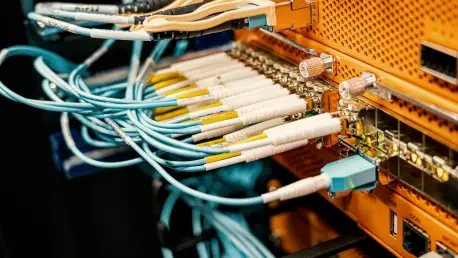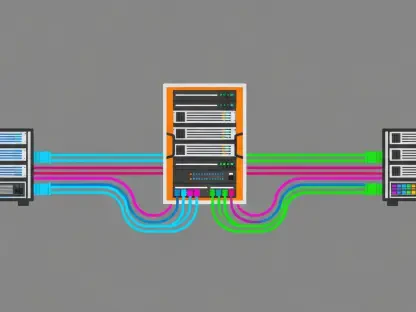In today’s rapidly evolving digital landscape, adapting to new technologies is crucial for any organization looking to stay ahead. Chloe Maraina, a leading expert in business intelligence with a strong background in data science, is here to discuss the transformation Network-as-a-Service (NaaS) brings to enterprise networking and the significant shifts it demands in cybersecurity strategies.
What is Network-as-a-Service (NaaS), and why has it become significant in the networking market?
NaaS is essentially a cloud-based model that offers network services as a subscription rather than through traditional physical hardware ownership. This shift to a service model has gained traction due to its ability to provide greater flexibility, scalability, and cost efficiency. In a world where agility is key, NaaS allows organizations to adapt their network resources as needed, removing the cost and complexity of maintaining physical infrastructure.
How does NaaS represent a paradigm shift in enterprise networking compared to traditional networking?
It’s a dramatic shift because it moves from a fixed, capital-intensive setup to a flexible and scalable subscription model. This transition allows businesses to pay for what they use, which aligns networking costs with actual business needs. As enterprise needs evolve, so too can their network infrastructure, providing unmatched agility compared to traditional systems.
What is the projected growth rate for the NaaS market, and what value is it expected to reach by 2032?
The NaaS market is expected to expand at an impressive rate of 26.7% annually, reaching $115.5 billion by the year 2032. This growth underscores the increasing adoption and trust in NaaS as organizations pursue more adaptable, cost-effective networking solutions.
How does the architectural shift introduced by NaaS impact the security strategy for networks?
With NaaS, security strategies need a complete overhaul. Traditional security models are designed for static, on-premises environments with defined boundaries. In contrast, NaaS operates in dynamic, distributed, and multi-tenant environments, requiring a flexible, software-defined security architecture. Security controls must now adapt in real-time to ever-changing network conditions.
Why is a software-defined security architecture necessary for NaaS environments?
In a NaaS environment, the boundary lines are not as clear as with a traditional setup. A software-defined security architecture allows for the flexibility and responsiveness needed to manage and secure these fluid boundaries. It ensures that security measures are as dynamic as the service environment itself, efficiently handling multiple tenants and evolving threats.
Can you explain why moving to NaaS should not be a lift-and-shift exercise?
Simply transplanting existing network configurations and security controls into a NaaS environment won’t work due to their fundamentally different architectures. NaaS environments require a redesign of network strategies to fully leverage the benefits they offer. It’s an opportunity to reevaluate and refine security policies rather than transferring outdated ones.
What steps should organizations take before implementing NaaS security controls?
Prior to implementation, conducting a comprehensive technical assessment is crucial. Organizations need to map existing security control points, understand data flows, and identify any gaps in the current setup versus what the NaaS environment demands. It’s also a time to update security policies and remove any technical debt.
How can transitioning to an as-a-service model help organizations clean up security policies and remove technical debt?
The shift allows organizations to streamline their policies by eliminating outdated or redundant security measures, aligning them with current needs and capabilities. This cleanup is not just about efficiency but also about improving the effectiveness of security frameworks, removing complex layers that often lead to vulnerabilities.
What are the core architectural differences between traditional network security and NaaS?
Traditional network security relies heavily on perimeter-based defenses with static boundaries, while NaaS is inherently more dynamic. NaaS architectures operate with shared responsibility models and demand continuous authentication, microsegmentation, and a focus on identity-based security mechanisms to manage shifting boundaries and distributed resources.
What does the shared responsibility model in NaaS entail for organizations in terms of security?
In a shared responsibility model, while the NaaS provider handles the infrastructure and edge security, the organization’s responsibility shifts to protecting their data, applications, and access controls. It requires a collaborative approach to security where responsibilities are clearly defined and managed consistently with the provider.
What are some technical security challenges that are unique to NaaS environments?
NaaS presents specific challenges like securing distributed cloud-native network layers, managing identity policies, and ensuring east-west traffic visibility. Misconfigurations, weak tenant isolation, and poor monitoring can lead to vulnerabilities, making robust identity management and precise segmentation essential.
How do misconfigured identity policies and lack of east-west traffic visibility complicate security in NaaS?
Misconfigured identity policies can lead to unauthorized access and exploitation, while a lack of visibility into east-west traffic within the network makes it difficult to detect and mitigate threats moving laterally. These issues necessitate more advanced identity management solutions and segmentation strategies to maintain stringent access controls and activity monitoring.
What role does identity management play in securing NaaS infrastructures?
Identity management is pivotal in a NaaS setup, given the absence of traditional network perimeters. It requires a shift from static credential checks to dynamic, context-aware identity verification processes to manage access across dispersed services securely and effectively.
What approach should organizations take to build a solid technical security strategy for NaaS?
Organizations must adopt a structured approach that includes thorough initial assessments, identifying vulnerabilities, setting clear success criteria, and defining explicit roles and responsibilities. Following this with a phased implementation plan ensures an organized transition, helping maintain robust security throughout the process.
Why is a comprehensive risk assessment important when transitioning to NaaS?
A comprehensive risk assessment helps to identify potential vulnerabilities and compliance needs, laying the groundwork for a solid security roadmap. This proactive approach ensures that all aspects of the transition are systematically addressed, reducing the risk of oversights or unexpected issues.
What elements should be included in the roadmap for a successful transition to NaaS?
The roadmap should incorporate risk management strategies, clear security policies, established success milestones, and well-defined roles. It should also include a framework for continuous evaluation and improvement to adapt to evolving threats and ensure ongoing alignment with organizational goals.
How do authentication mechanisms factor into the implementation of security controls for NaaS?
Authentication mechanisms are central to securing access in a NaaS environment. Implementing a broad spectrum of protocols such as OAuth, SAML, and OIDC is crucial for ensuring secure login and data access processes. Such diversity in authentication methods enhances security by making it more resistant to phishing and unauthorized access.
What are the benefits of implementing microsegmentation in NaaS environments?
Microsegmentation allows for detailed traffic control and isolation of network segments, significantly reducing the attack surface. By controlling application-level communications, it helps prevent lateral movement of threats within the network, ensuring comprehensive protection of sensitive data and services.
How should applications, data, and users be prioritized when implementing microsegmentation?
Prioritization should be based on assessing data sensitivity, application criticality, and user roles. Identifying traffic patterns and understanding specific requirements will guide effective segmentation. This helps in minimizing disruptions while enhancing security management and control.
What operational considerations are important for a NaaS security strategy?
Operationally, it’s vital to include ongoing monitoring, regular evaluations, and updates to security measures. Implementing phased migrations, continuous improvement practices, and close collaboration with providers to ensure alignment on security protocols is also critical for maintaining effective NaaS security operations.
What best practices should be followed for operational excellence in managing NaaS security?
Practices such as phased security validation, specialized threat modeling, and routine security strategy updates are key. Continuous provider coordination and clear communication of expectations and capabilities also ensure seamless operations and adherence to security requirements.
How can organizations ensure the effectiveness of their NaaS security measures while adapting to changing threats?
Organizations need to incorporate regular training, conduct periodic security reviews, and stay updated with emerging threats to ensure adaptability. Integrating these practices into security strategies ensures the measures remain relevant and effective against evolving threats.
What is the importance of provider coordination in transitioning to a NaaS environment?
Effective provider coordination ensures that security measures are aligned with the provider’s capabilities and infrastructure. It helps define the shared responsibility model clearly, ensuring smooth integration and uniformity in addressing vulnerabilities and security compliance.
What role do service-level agreements (SLAs) play in maintaining NaaS security?
SLAs are crucial as they outline the expectations for vulnerability management, continuous monitoring, and timely issue resolution. Clear SLAs help establish accountability and ensure that providers meet necessary security and performance benchmarks consistently.
Why should organizations ensure NaaS providers align with the NIST Cybersecurity Framework?
Aligning with the NIST Cybersecurity Framework ensures comprehensive coverage of essential security functions like identify, protect, detect, respond, and recover. It provides a standardized approach to assessing and managing cybersecurity risks, ensuring all necessary precautions are in place.
What industry standards should organizations look for when evaluating NaaS providers for security?
Key industry standards include SOC 2, PCI DSS, HIPAA, ISO 27001, and GDPR compliance. These standards ensure that providers maintain rigorous security protocols and meet global regulatory requirements, providing assurance of their ability to safeguard sensitive data and systems.
Do you have any advice for our readers?









